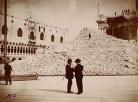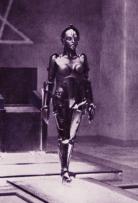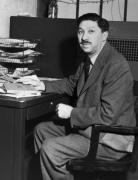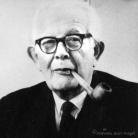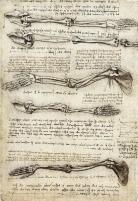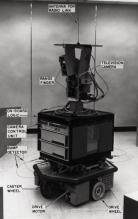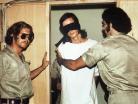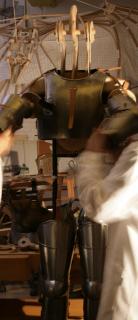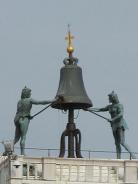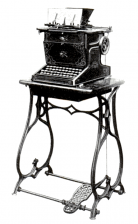in the year 1000, under Doge Pietro II Orseolo, Dalmatia was finally in complete control of the Venetians after many years of battle, tribute-payment, and political maneuvering in response to Dalmatian pirates. This marked the beginning of the Venetian empire. Image: the extent of the Kingdom of Dalmatia (blue), on a map of modern-day Croatia. This file is licensed under the Creative Commons Attribution Share Alike 3.0 Unported license.
Making the Human/ Inventing Venice
Created by Dino Franco Felluga on Fri, 12/30/2016 - 10:56
Part of Group:
This timeline allows students to see important events connected to the transition from Medieval to Renaissance Italy (focussed especially on Venice).
Timeline
Associated Places
No places have been associated with this eventby Sahil Lala
Invention of Movable Type in China
circa. 1041 to circa. 1048
Associated Places
No places have been associated with this eventby Laura Titzer
The Beginnings of the Arsenal of Venice
1150 to 1200
Associated Places
No places have been associated with this eventby Jacob Hussey
Associated Places
No places have been associated with this eventThird Crusade
1189 to 1192
Third Crusade, led by Frederick I Barbarossa, Richard I (Lionheart of England), and Philip II of France. On June 1190, Frederick drowns. The crusade is not successful in its main goal of capturing Jerusalem. This failure led to the Fourth Crusade six years later. Image: Bust of Friedrich I., "Barbarossa", gilded bronze, ca. 1160 (image by Montecappio). This file is licensed under the Creative Commons Attribution 3.0 Unported license.
Associated Places
No places have been associated with this eventFourth Crusade
1202 to 1204
Fourth Crusade. The initial goal was the capture of Jerusalem but the invaders ended up instead invading Constantinople, the capital of the Byzantine empire (now Istanbul). Constantinople was seized at the end of of the Fourth Crusade, largely thanks to the political maneuvering of Doge Enrico Dandolo. As a result of the crusade, Venice controls the entire Eastern Adriatic. Venice also buys Crete from Boniface of Montferrat, leader of the crusade, thus ensuring that Venice controls the trade route to Constantinople and Asia Minor. As its part of the looting of Constantinople, Venice brings back the four horses that stand over the entrance of St. Mark’s Basilica. Image: Conquest of Constantinople By The Crusaders In 1204 (15th-century miniature). This work is in the public domain in its country of origin and other countries and areas where the copyright term is the author's life plus 70 years or less.
Associated Places
IstanbulVenice extends its imperial power by holding sway over the Duchy of the Archipelago, which was created by Marco Sanudo in 1207 (including the Greek islands of the Cyclades, especially Naxos).
Associated Places
Naxos, GreeceAssociated Places
No places have been associated with this eventby Jacob Hussey
Associated Places
No places have been associated with this eventby Hannah Mylin
Associated Places
No places have been associated with this eventby Kate Harris
Fondaco dei Turchi was first constructed in 1225 by Giacomo Palmieri and is considered one of the oldest buildings in Venice. The Venetian government took over this palace in 1831 and used it for the Duke of Ferrara, Nicholas II. The space was used for political purposes and then was turned into an Ottoman warehouse in 1621. After a period of disarray, it was resotred in 1858 by Camillo Boito. This information comes from www.venicexplorer.net. This photo is from Wikimedia Commons and is free to share.
Associated Places
No places have been associated with this eventAssociated Places
No places have been associated with this eventFlorin
1252
Associated Places
No places have been associated with this eventby Mara Kossoff
Wars with Genoa
1255 to 1380
Wars with Genoa. This is the time period when the two great thalassocracies of the period compete for control of the Mediterranean and of trade routes to the East. The first two Genoese Wars (1255-1270, 1294-9) produced naval victories for each side in an almost random pattern. On balance, the first war favored the Venetians and the second the Genoese. Fifty years of relative peace ensued, the belligerants heavily occupied by other challenges, including awesome onslaughts of plague. The Third Genoese War (1351-5) began well for the Venetians but ended badly. Control of the Genoa government, however, had passed to the Visconti family of Milan, and Venice was able to negotiate a better peace treaty than its military posture would have suggested. From one point of view the Fourth Genoese War (1378-81), called the War of Chioggia, can be viewed as a defeat for the Venetians, but Venice's dramatic and climactic victory at Chioggia, 1379-80, pulled defeat from the jaws of complete disaster. (See a Virtual History of Venice for more.) Image: The Lion of Saint Mark (By Tonchino - Extracted from Flag of Most Serene Republic of Venice.svg, Public Domain).
Associated Places
No places have been associated with this eventMarco Polo and the East
1266 to 1271
In 1266, Marco Polo’s father and uncle meet Kublai Khan in Dadu (present day Beijing, China). Kublai Khan asks them to deliver a letter to the Pope and requests that they return with 100 Christians acquainted with the Seven Arts (grammar, rhetoric, logic, geometry, arithmetic, music and astronomy) plus oil of the lamp in Jerusalem. In 1271, Marco Polo embarks with his father and uncle to visit Kublai Khan, finally arriving there around 1275 delivering the sacred oil from Jerusalem and letters from the Pope. Image: Marco Polo in Tartar costume (18th century; image by Grevembrock - Scanné de Coureurs des mers, Poivre d'Arvor., Public Domain).
Associated Places
BeijingLife of Giotto
circa. 1266 to circa. 1337
Giotto di Bondone was an Italian painter and architect from Florence, Italy. Giotto's masterwork is the decoration of the Scrovegni Chapel in Padua, also known as the Arena Chapel, completed around 1305. Image: Possible image of Giotto: detail of decoration in the Peruzzi Chapel, Church of Santa Croce, Florence, Italy. This detail has been digitally restored. This work is in the public domain in its country of origin and other countries and areas where the copyright term is the author's life plus 100 years or less.
Associated Places
No places have been associated with this eventThe Guild of Crystal Workers
Nov 1284
Associated Places
No places have been associated with this eventby Sahil Lala
Invention of the Eyeglasses
circa. 1286
Associated Places
No places have been associated with this eventCosts and Benefits of Making Glass
circa. 1291
Associated Places
No places have been associated with this eventIn 1297, establishment of Venice’s republican regime. In the act known as the Serrata (Closing of the Great Council), membership in the city’s ruling class was limited to a select set of nearly two hundred families. Image: Chamber of the Great Council (picture by Sailko and distributed under the terms of the GNU Free Documentation License.
Associated Places
No places have been associated with this eventContributions of Spina
circa. 1300
Associated Places
No places have been associated with this eventby Sahil Lala
Construction of the Doge's Palace:
circa. 1301 to circa. 1450
Associated Places
No places have been associated with this eventby Teresa Ortyl
Giordanos' Sermon
23 Feb 1306
Associated Places
No places have been associated with this eventby Sahil Lala
Creation of the Council of Ten
10 Jul 1310
On 10 July 1310, creation of the Council of Ten in response to the revolt against the Doge led by Bajamonte Tiepolo. The Council of Ten was composed of ten members elected to a one-year term by the Great Council. Members could not be elected for two successive terms. Image: The death of Doge Marin Faliero by Francesco Hayez. This work is in the public domain in its country of origin and other countries and areas where the copyright term is the author's life plus 100 years or less.
Associated Places
No places have been associated with this eventAssociated Places
No places have been associated with this eventby Justin Chan
In 1320, the “Nuovo Arsenale” was added on to the Arsenal of Venice. The Nuovo Arsenale digresses from the Byzantine design of the former “Arsenale Vecchio” as well as provides much more room for producing and maintaining the growing merchant and militant navy. The Nuovo Arsenale helped the Venetian Empire build more ships at a faster pace than before. This picture is okay to use because this file is licensed under the Creative Commons Attribution-Share Alike 3.0 Unported license. Source: www.aviewoncities.com/venice/a….
Associated Places
No places have been associated with this eventby Jacob Hussey
Life of Guisto de’ Menabuoi
circa. 1320 to circa. 1391
Life of Guisto de’ Menabuoi, an Italian painter of the early Renaissance: c. 1320-1391. Image: Detail of Paradise, Dome of the Padua Baptistry, by Giusto de' Menabuoi (Web Gallery of Art, public domain).
Associated Places
No places have been associated with this eventWar with the Della Scala empire
1328 to 1329
The Della Scala family, the rulers of Verona, capture Padua and Treviso, thus bringing the Della Scala empire to the shores of Venice itself, forcing Venice to attack in October 1336, leading to the capture of Padua and a military alliance with Milan, Manua, Este and Florence. The resulting peace treaty with the Della Scala family also gave Venice Treviso. Venice placed her new mainland territories under the rule of the Carreras of Padua who helped Venice defeat the Della Scala family; however, the Carreras then sought to get out from under Venetian control.
Associated Places
No places have been associated with this eventThe Bubonic Plague began is said to have began in 1347. As medicine was not advanced, over 25 million people died. Although the bubonic plague is found mostly in small rodents and is transmitted to humans through fleas. Once caught, the plague is very contagious and killed quickly. Symptoms include fever, chills, weakness, and headache. This information is from the CDC and www.themiddleages.net. This photo is from Wikimedia Commons and is free to share.
Associated Places
No places have been associated with this eventThe Black Death devastated Venice in 1348, reducing its population by one half. Plague occurred in Venice 22 times between 1361 and 1528. Image: The Dance of Death by Michael Wolgemut (1493) from the German printed edition, folio CCLXI recto from Hartman Schedel's Chronicle of the World (Nuremberg, 1493) thought to be created by Michael Wolgemut (b. 1434, Nürnberg, d. 1519, Nürnberg). This work is in the public domain in its country of origin and other countries and areas where the copyright term is the author's life plus 100 years or less.
Associated Places
No places have been associated with this eventAssociated Places
No places have been associated with this eventby Sahil Lala
Associated Places
No places have been associated with this eventWestern Schism (Papal Schism)
circa. 1378 to circa. 1418
Associated Places
No places have been associated with this eventFourth Genoese War (War of Chiogga)
1378 to 1381
Fourth Genoese War (also termed the War of Chiogga). The Carraras of Padua sided with the Genoans. Despite being surrounded and near defeat, Venice managed to defeat the Genoese fleet at Chiogga. Exhausted by her wars, Venice elected to cede Treviso and her other mainland possessions to the Duke of Austria, whom she deemed to be less of a long-term threat than the Carraras. Venice retreats to her island fortress.
Associated Places
No places have been associated with this eventTreviso under seige
1382 to 1388
From 1382-88, the Carraras placed Treviso under seige and offered Austrians 100,000 ducats for Treviso and the other former mainland possessions of Venice; however, in 1388 Venice arranged an alliance with Milan. Milanese forces captured Padua and returned Treviso to permanent Venetian control, retaining Padua and its western possessions for itself.
Associated Places
Treviso, ItalyLife of Donatello
1386 to 1466
Life of Donatello (Donato di Niccolò di Betto Bardi), an early Renaissance sculptor from Florence: c. 1386-1466. Image: Donatello's equestrian statue of Gattamelata at Padua, the first example of such a monument since ancient times (public domain).
Associated Places
No places have been associated with this eventWar for control of Padua
1390 to 1404
Venice sided with the Carraras again (along with Florence and Bologna) to oust Milan from Padua. Once the Carraras were back in power in Padua, they attacked Milan-controlled Vicenza. The Milanese arranged for Venice to attack Padua to stop the Carraran western advance. Venetians captured Padua in November 1404; they executed Francesco Carrara and his son Jacopo. Venetians now controled Padua, Vicenza and Verona, along with Treviso.
Associated Places
Padua (Padova)Life of Jacopo Bellini
circa. 1396 to circa. 1470
Life of Jacopo Bellini, father of Gentile and Giovanni Bellini and father-in-law of Andrea Mantegna. Image: Jacopo Bellini, Madonna and Child, c. 1465 (Los Angeles County Museum of Art). This file is in the public domain because it has been released by the Los Angeles County Museum of Art with its "Public Domain High Resolution Image Available" mark.
Associated Places
No places have been associated with this eventAssociated Places
No places have been associated with this eventby Mara Kossoff
Shift from Tempera Paints to Oil Paints
circa. 1400 to circa. 1500
Associated Places
No places have been associated with this eventby Kate Harris
Associated Places
No places have been associated with this eventPopularity of Patronage
circa. 1400 Mid to Late 1400s
Associated Places
No places have been associated with this eventby Mara Kossoff
Trend of Patronage
circa. 1400
Associated Places
No places have been associated with this eventby Mara Kossoff
Associated Places
No places have been associated with this eventCouncil of Constance resolves Western Schism
1414 to 1418
Associated Places
No places have been associated with this eventFriuli placed under Venetian control
1418 to 1420
Venice acquired Friuli from 1418-1420 as a result of tensions with the King of Hungary, who had gained control of Dalmatia. In 1420, the Venetians succeeded against the Patriarch of Aquileia, thus wresting control of Udine (and doubling her mainland territory). In the same year, Venice reasserted her control of Dalmatia.
Associated Places
No places have been associated with this eventFall of Constantinople
1424 to 1453
Eventual Ottoman victory over the Byzantine Greeks, culminating in the fall of Constantinople (now Istanbul). All Venetian outposts in the eastern Mediterranean were suddenly at risk.
Associated Places
IstanbulWars in Lombardy:
1425 to 1454
The wars in Lombardy were a series of struggles between the Republic of Venice and the Duchy of Milan, leading to the five major Italian territorial powers that make up the map of Italy until the Italian Wars (i.e., Venice, Milan, Florence, Naples, and the Papacy). The wars ravaged the economy of Lombardy and weakened the power of Venice. The Peace of Lodi in 1454 brought 40 years of comparative peace to Northern Italy. This is the time of the Medici rule of Florence, first Cosimo de’ Medici, then Piero “the Gouty,” then Lorenzo Il Magnifico. The death of Lorenzo marked the end of the Golden Age of Renaissance Florence. Both Leonardo da Vinci and Michelangelo Buonarroti were active (and tied to Lorenzo) during this period. In 1428, Venice acquired Brescia and Bergamo as a result of this struggle.
Associated Places
No places have been associated with this eventJoan of Arc's Victory
Jan 1428
Associated Places
No places have been associated with this eventby Mara Kossoff
Associated Places
No places have been associated with this eventby Hannah Mylin
Life of Mauro Codussi
1440 to 1504
Associated Places
No places have been associated with this eventAldus Manutius
1449 to 6 Feb 1515
Associated Places
No places have been associated with this eventby Laura Titzer
1) Johannes Gutenberg got the final design of the printing press working in 1450. His first project was printing indulgences that the Church used, In 1451 he used the printing press to produce copies of the Bible, resulting in the famous Gutenberg Bible. Success of the printing press came from increased literacy rates. His printing press was used throughout Europe in the following years. This information came from Oregon State. This photo is from Wikimedia Commons and is free to share.
Associated Places
No places have been associated with this eventLeonardo da Vinci
15 Apr 1452
Associated Places
No places have been associated with this eventAssociated Places
No places have been associated with this eventby Laura Titzer
Associated Places
No places have been associated with this eventAssociated Places
No places have been associated with this eventby Jacob Hussey
Associated Places
No places have been associated with this eventby Mara Kossoff
Sixtus IV Reigns as Pope
9 Aug 1471 to 12 Aug 1484
Associated Places
No places have been associated with this eventNicolaus Copernicus
1473 to 1543
Associated Places
No places have been associated with this eventby Hannah Mylin
Oldest Surviving Pair of Glasses
circa. 1475
Associated Places
No places have been associated with this eventby Sahil Lala
Sebastiano Serlio
6 Sep 1475 to 1554
Sebastiano Serlio was born Bologna on September 6, 1475. He was an Italian architect and thespian who focused designing theaters. Serlio is most known for his book on architructe, Tutte l’opere d’architettura, et prospetiva. He drew upon the Greek and Roman style of architecture for his designs. Most of his buildings have either been replaced by new buildings or were not considered influential enough to receive much recognition. After his work in Italy, Serlio went on to build palaces and chateaus in France, most notably the palace of Fontainebleau. He died in 1554. This information is from Britannica and Italian Renaissance Theatre. The photo is from Williams College Magazine in an article titled The Italian Job.
Associated Places
No places have been associated with this eventGian Giorgio Trissino
1478 to 1550
Associated Places
No places have been associated with this eventby Tim Brunner
The Revolving Bridge
circa. 1480
Associated Places
No places have been associated with this eventda Vinci's Catapult
circa. 1480
Associated Places
No places have been associated with this eventLeonardo Da Vinci painted the Lady with an Ermine with specific scientific goals in mind. He was exploring the effects of light on a subject, and the lighting seen here is so precise that one can calculate the distance the light is placed from the subject in the painting. Only by understanding light could a true 3D representation be made on paper. Other works of the time played very little with depth, especially in representing the facial features of a human. These often appeared bland, with every contour equally visible and under the same color shade. Unlike these two-dimensional representations, the Lady with an Ermine is situated with her body at an angle and there are clear gradients of light across her face and chest. This attention to detail by observation of the natural world parallels the focus in medicine and other scientific fields (in which Da Vinci was directly involved)
Associated Places
No places have been associated with this eventby Hannah Mylin
Associated Places
No places have been associated with this eventThe Ideal City
1485
Associated Places
No places have been associated with this eventOrnithopter
1485
Associated Places
No places have been associated with this eventAssociated Places
No places have been associated with this eventby Mara Kossoff
Giant Crossbow
1486
Associated Places
No places have been associated with this eventAssociated Places
No places have been associated with this eventThe Armored Car
1487
Associated Places
No places have been associated with this eventAssociated Places
No places have been associated with this eventby Jacob Hussey
Vitruvian Man
1490
Associated Places
No places have been associated with this eventTiziano (Titian) Vecelli
1490 to 1576
Tiziano Vecelli was born around 1490 and died in 1576 and was one of the most important artists in Venice, especially in the Venice school of art. He often went just by the name of Titian. In Padua in 1511, Titian’s true talent of fresco painting was shown and was later commissioned to finish many of the frescos in Venice that had been started by Giovanni Bellini. In 1521, Titian did the St. Sebastian figure. In 1528 he was actually fired by the government in Venice because they were unhappy with his work. In 1576, the plague killed Titan. This information is form www.titian-tizianovecellio.org. This photo is from Wikimedia Commons and is free to share.
Associated Places
No places have been associated with this eventRodrigo Borgia Reigns as Pope Alexander VI
11 Aug 1492 to 18 Aug 1503
Associated Places
No places have been associated with this eventOn October 12th, 1492, Christopher Columbus and his crew finally saw land, which they thought was India but was actually the Americas. They had been at sea for 10 weeks, so the sight of land was huge relief for the crew. This was critical event as it considered Europe’s most noteworthy interaction with people not located in Afro-Eurasia. This began the European idea of exploration of new lands for resources and eventually colonization. This information came from www.americaslibrary.gov. This photo is from Wikimedia Commons and is free to share.
Associated Places
No places have been associated with this eventAssociated Places
No places have been associated with this eventby Laura Titzer
Associated Places
No places have been associated with this eventby Laura Titzer
Leonardo's Mechanical Knight
1495 to 1495
Associated Places
No places have been associated with this eventAssociated Places
No places have been associated with this eventAssociated Places
No places have been associated with this eventby Kai Strubel
Associated Places
No places have been associated with this eventCustodians Live in St. Mark's Clock Tower
1499 to 1998
Associated Places
No places have been associated with this eventSt. Mark's Clock Revealed
1 Feb 1499
Associated Places
No places have been associated with this eventGlasses available to the general public
circa. 1500
Associated Places
No places have been associated with this eventby Sahil Lala
Fantasia Music:
circa. 1500
Associated Places
No places have been associated with this eventby Justin Chan
Associated Places
No places have been associated with this eventAssociated Places
No places have been associated with this eventby Kate Harris
Associated Places
No places have been associated with this eventby Laura Titzer
Statue of David Unveiled to the Public
The start of the month Sep 1504
Associated Places
No places have been associated with this eventby Kai Strubel
Life of Thomas Tallis:
1505 to 20 Nov 1585
Associated Places
No places have been associated with this eventby Justin Chan
Da Vinci and the Human Heart
circa. 1506 to circa. 1519
Associated Places
No places have been associated with this eventby Kate Harris
Painting of Sistine Chapel
1508 to 1512
Associated Places
No places have been associated with this eventLife of Andrea Palladio
30 Nov 1508 to 19 Aug 1580
Associated Places
Padua (Padova)Life of Bartolomeo Eustachi
1510 to 1574
Associated Places
No places have been associated with this eventby Kate Harris
Associated Places
No places have been associated with this eventby Hannah Mylin
The Life of Antonio da Ponte:
1512 to 1597
Associated Places
No places have been associated with this eventby Teresa Ortyl
Associated Places
No places have been associated with this eventby Kai Strubel
Life of Andreas Vesalius
1514 to 1564
Associated Places
No places have been associated with this eventby Kate Harris
Daniele Barbaro
1514 to 1570
Associated Places
No places have been associated with this eventby Tim Brunner
Associated Places
No places have been associated with this eventby Laura Titzer
Associated Places
No places have been associated with this eventby Sahil Lala
Luther's Ninety-Five Theses
31 Oct 1517
Associated Places
No places have been associated with this eventFirst Printed Talmud
1520 to 1523
Associated Places
No places have been associated with this eventby Laura Titzer
Madrigal Vocal Music:
circa. 1520
Associated Places
No places have been associated with this eventby Justin Chan
Life of Giovanni Antonio Rusconi
1520 to 1579
Associated Places
No places have been associated with this eventby Teresa Ortyl
Associated Places
No places have been associated with this eventby Teresa Ortyl
Associated Places
No places have been associated with this eventWars of Religion
1524 to 1648
Associated Places
No places have been associated with this eventby Mara Kossoff
Associated Places
No places have been associated with this eventAssociated Places
No places have been associated with this eventSack of Rome
6 May 1527
Associated Places
No places have been associated with this eventAssociated Places
No places have been associated with this eventAssociated Places
No places have been associated with this eventVilla Trissino in Cricoli
circa. 1530 to circa. 1538
Associated Places
No places have been associated with this eventby Tim Brunner
Who Ivan the Terrible Actually Was
1533 to 1547
Associated Places
No places have been associated with this eventby Mara Kossoff
Palladian Window
1537
The Palladian window consists of three individual windows: a large, arched window in the middle accompanied by two narrower windows on each side. This style of window was popularized by Andrea Palladio, but the style can be traced back to Sebastiano Serlio in his book L’architettura, written in 1537. Sometimes this style of window is referred to as the Venetian window or Serlian motif. This window was used in European and American architecture after the Renaissance. This information is from Britannica and Lindsay Daniel Architecture. The image is from Wikimedia Commons and is Public Domain.
Associated Places
No places have been associated with this eventVenetian polychoral style
1540 to 1600
Associated Places
No places have been associated with this eventby Kate Harris
Located on the wall of the Sistine Chapel in the Vatican, the Last Judgement is a fresco by Italian Renaissance master Michelangelo. The painting shows God’s final judgement of all humanity. The painting depicts God in the middle of a mass of humans, pulling some up to heaven and damning others to hell. God is surrounded by depictions of many famous saints. The work is considered revolutionary because Michelangelo did not depict the figures by their social position, but rather showed everyone in equal standing, bare before God. The piece received mixed reception. Some believed that nude figures should not be shown in such a sacred place. The work took Michelangelo four years to complete. He was commissioned by Pope Clement VII to paint the resurrection, but when the pope died, Pope Paul III believed the Last Judgement was a more fitting subject. This file is licensed under the Creative Commons Attribution Share Alike 3.0 Unported License.
Associated Places
No places have been associated with this eventby Kai Strubel
Associated Places
No places have been associated with this eventby Tim Brunner
Villa Godi
1542
Associated Places
No places have been associated with this eventby Tim Brunner
Associated Places
No places have been associated with this eventby Hannah Mylin
Associated Places
No places have been associated with this eventby Kai Strubel
Associated Places
No places have been associated with this eventby Kate Harris
Life of William Byrd:
1543 to 4 Jul 1623
Associated Places
No places have been associated with this eventby Justin Chan
Council of Trent
1545 to 1563
Associated Places
No places have been associated with this eventAssociated Places
No places have been associated with this eventby Hannah Mylin
Vincenzo Scamozzi
1548 to 1616
Associated Places
No places have been associated with this eventby Tim Brunner
Palladian Basilica
1549 to 1614
The Palladian Basilica started renovation in 1549 and was fully completed in 1614. Palladio designed the major renovations, however, died before the project was completed. It was intended to be used as a public space for the people. The upper floor is one giant room, with no columns supporting the weight of the roof. During construction, part of the famous two-story loggias, or porches, collapsed, thus Palladio was hired to fix the engineering issues of the building. It is located in the Piazza dei Signori. This information is from www.museicivicivicenza.it/en. The picture is from Wikimedia Commons and is free to share.
Associated Places
No places have been associated with this eventThe Venetian School
1550 to 1610
The Venetian School helped develop music composers from 1550-1610. It was housed in the Basilica San Marco due to its unique architecture that made it a great space for music and choir. The invention of the printing press also allowed composers to print music, which drew even more musicians and composers to Venice. The most notable music productions had elements of a choir, brass, sting, and organs to create a mesmerizing sound.
Associated Places
No places have been associated with this eventLife of Giovanni Gabrieli
1554 to 1612
Associated Places
No places have been associated with this eventby Kate Harris
Peace of Augsburg
25 Sep 1555
Associated Places
No places have been associated with this eventAssociated Places
No places have been associated with this eventConstruction of the New Prison:
circa. 1560 to circa. 1614
Associated Places
No places have been associated with this eventby Teresa Ortyl
San Francesco della Vigna facade
1564 to 1570
Associated Places
No places have been associated with this eventby Tim Brunner
Life of Antonio Contin
1566 to 1600
Associated Places
No places have been associated with this eventby Teresa Ortyl
Villa Capra “La Rotonda” is one of the most recognizable buildings from the Renaissance. Construction started in 1567 on the project and was designed by Palladio. During construction, Palladio died and Vincenzo Scamozzi took over the project. Neither Palladio nor Paolo Almerico, the owner, were present for the physical construction of the building. The villa was designed to be located in the suburbs, however, it is now a country farm. The building is a square and each side has its own façade. Palladio originally intended for the roof to be dome-shaped, but it was finished with smaller dome topped with a cupola. This information is from architectuul.com. The photo is from Wikimedia Commons and is free to share.
Associated Places
No places have been associated with this eventAssociated Places
No places have been associated with this eventby Tim Brunner
Associated Places
No places have been associated with this eventby Jacob Hussey
Associated Places
No places have been associated with this eventby Mara Kossoff
Il Redentore
1576 to 1591
Associated Places
No places have been associated with this eventby Tim Brunner
The 1577 Fire in the Doge's Palace:
20 Dec 1577
Associated Places
No places have been associated with this eventby Teresa Ortyl
Associated Places
No places have been associated with this eventby Kai Strubel
Associated Places
No places have been associated with this eventby Justin Chan
My Ladye Nevells Booke:
11 Sep 1591
Associated Places
No places have been associated with this eventby Justin Chan
The University of Padova’s Anatomical Theater
1594 to 1872
Associated Places
No places have been associated with this eventby Kate Harris
Associated Places
No places have been associated with this eventby Hannah Mylin
Associated Places
No places have been associated with this eventby Hannah Mylin
Shakespeare's Globe Theatre
1599 to 1644
Associated Places
No places have been associated with this eventAssociated Places
No places have been associated with this eventby Sahil Lala
Baroque Period (Music):
circa. 1600 to circa. 1750
Associated Places
No places have been associated with this eventby Justin Chan
Counterpoint:
circa. 1600
Associated Places
No places have been associated with this eventby Justin Chan
Construction of the Bridge of Sighs:
1600 to 1602
Associated Places
No places have been associated with this eventby Teresa Ortyl
Associated Places
No places have been associated with this eventAssociated Places
No places have been associated with this eventby Laura Titzer
Invention of the Telescope
2 Oct 1608
Associated Places
No places have been associated with this eventGalileo's Early Telescope
Jun 1609
Associated Places
No places have been associated with this eventAssociated Places
No places have been associated with this eventby Kai Strubel
Associated Places
No places have been associated with this eventNaming of the Telescope
14 Apr 1611
Associated Places
No places have been associated with this eventGalileo published findings that contradicted the Aristotelian way of thinking in “Discourse on Bodies of Water”. It argued that objects do not float because of their flat shape but because of their relative weight to the water they displace. Galileo also started mounting evidence in support of the Copernican theory, contradicting the views of the Church and Aristotle. 1616 Church order Galileo not to “hold, teach, or defend, or defend in any manner” the Copernican theory. This file is licensed under the Creative Commons Attribution Share Alike 3.0 Uported License.
Associated Places
No places have been associated with this eventby Kai Strubel
Associated Places
No places have been associated with this eventby Kai Strubel
Galileo is tried by the Inquisition
Sep 1632 to Jul 1633
Associated Places
No places have been associated with this eventby Kai Strubel
Invention of the Micrometer
circa. 1635
Associated Places
No places have been associated with this eventAssociated Places
No places have been associated with this eventDecline of the Venetian Navy
1650 to 1700
Associated Places
No places have been associated with this eventby Jacob Hussey
Publication of Systema Saturnium
circa. 1659
Associated Places
No places have been associated with this eventAssociated Places
No places have been associated with this eventDigesting Duck
1739
Associated Places
No places have been associated with this eventSt. Mark's Clock Renovation
1752 to 1757
Associated Places
No places have been associated with this eventAssociated Places
No places have been associated with this eventby Teresa Ortyl
Associated Places
No places have been associated with this eventFrench Revolution
5 May 1789 to 10 Nov 1799
 The French Revolution occurred from 5 May 1789 to 9-10 November 1799. Image: Jean-Jacques-François Le Barbier, Representation of The Declaration of the Rights of Man and of the Citizen of 26 August 1789 (c. 1789). This work is in the public domain in the United States.
The French Revolution occurred from 5 May 1789 to 9-10 November 1799. Image: Jean-Jacques-François Le Barbier, Representation of The Declaration of the Rights of Man and of the Citizen of 26 August 1789 (c. 1789). This work is in the public domain in the United States.
On 5 May 1789, the Estates-General, representing the nobility, the clergy, and the common people, held a meeting at the request of the King to address France’s financial difficulties. At this meeting, the Third Estate (the commoners) protested the merely symbolic double representation that they had been granted by the King. This protest resulted in a fracture among the three estates and precipitated the French Revolution. On 17 June, members of the Third Estate designated themselves the National Assembly and claimed to represent the people of the nation, thus preparing the way for the foundation of the republic. Several pivotal events followed in quick succession: the storming of the Bastille (14 July), the approval of the Declaration of the Rights of Man and of the Citizen (26 August), and the march on Versailles that led to the enforced relocation of the royal family to Paris (5-6 October). These revolutionary acts fired the imagination of many regarding the political future of France, and, indeed, all of Europe. The republican period of the revolution continued in various phases until 9-10 November 1799 when Napoleon Bonaparte supplanted the government.
Articles
Diane Piccitto, "On 1793 and the Aftermath of the French Revolution"
Associated Places
ParisExecution of King Louis XVI
21 Jan 1793
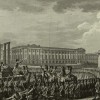 On January 21, 1793, King Louis XVI of France was executed. Image: Isidore-Stanislas Helman, The Death of King Louis (1794), Bibliothèque nationale de France. This work is in the public domain in the United States.
On January 21, 1793, King Louis XVI of France was executed. Image: Isidore-Stanislas Helman, The Death of King Louis (1794), Bibliothèque nationale de France. This work is in the public domain in the United States.
1793 was a key juncture in the revolution, beginning with this execution on 21 January. The increasing violence prompted Britain to cut its ties to France, leading to declarations of war by the two countries. Violence peaked during the Reign of Terror (5 September 1793 – 27 July 1794), which resulted in the execution of the Queen (16 October) as well as of many suspects of treason and members of the Girondins, the more moderate faction that the radical Jacobins brought down on 2 June 1793
Articles
Diane Piccitto, "On 1793 and the Aftermath of the French Revolution"
Associated Places
Bibliothèque nationale de FranceReign of Terror
5 Sep 1793 to 27 Jul 1794
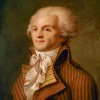 A period of violence that occurred a few years after the start of the French Revolution. Image: Anonymous, Portrait of Maximilien de Robespierre (c. 1790), Carnavalet Museum. This image is in the public domain in the United States because its copyright has expired.
A period of violence that occurred a few years after the start of the French Revolution. Image: Anonymous, Portrait of Maximilien de Robespierre (c. 1790), Carnavalet Museum. This image is in the public domain in the United States because its copyright has expired.
On 5 September 1793, the National Convention, France’s ruling body from 1793 to 1795, officially put into effect terror measures in order to subdue opposition to and punish insufficient support for the revolution and the new regime. From the autumn of 1793 until the summer of 1794, thousands of people across the country were imprisoned and executed (including the Queen) under the ruthless leadership of Maximilien Robespierre. The guillotine, particularly the one in Paris’s Place de la Révolution, served as the bloody emblem of the fear tactics that began to manifest themselves first in the formation of the Committee of Public Safety (6 April 1793) and subsequently in the implementation of the Law of Suspects (17 September 1793). The Terror ended on 27 July 1794 with the overthrow of Robespierre, who was guillotined the next day.
Articles
Diane Piccitto, "On 1793 and the Aftermath of the French Revolution"
Associated Places
ParisAssociated Places
No places have been associated with this eventNapolean and the Arsenal of Venice
1800 to 1815
Associated Places
No places have been associated with this eventby Jacob Hussey
Napoleon made king of Italy
26 May 1805
 On 26 May 1805, Napoleon crowns himself King of Italy in Milan Cathedral, with the iron crown of Lombardy. Image: The Iron Crown of Lombardy, from Cesare Cantù Grande illustrazione del Lombardo-Veneto ossia storia delle città, dei borghi, comuni, castelli, ecc. fino ai tempi moderni Milano, Corona e Caimi Editori, 1858. This image is in the public domain in the United States because its copyright has expired.
On 26 May 1805, Napoleon crowns himself King of Italy in Milan Cathedral, with the iron crown of Lombardy. Image: The Iron Crown of Lombardy, from Cesare Cantù Grande illustrazione del Lombardo-Veneto ossia storia delle città, dei borghi, comuni, castelli, ecc. fino ai tempi moderni Milano, Corona e Caimi Editori, 1858. This image is in the public domain in the United States because its copyright has expired.
In a flamboyant and highly theatrical gesture, Napoleon Bonaparte signifies his political and military dominance over the Italian peninsula with a ceremony in Milan Cathedral, where he crowned himself King of Italy with the ancient, iconic iron crown of Lombardy. This crowning of Napoleon as King is a result of the French conquest of Italy. His full title was "Emperor of the French and King of Italy."
Articles
Alison Chapman, "On Il Risorgimento"
Related Articles
Erik Simpson, “On Corinne, Or Italy”
Associated Places
Benjamin Robert Haydon, Napoléon Bonaparte (based on a version of 1830)Umbria
Florence, Italy
Ravenna
The Kingdom of the Two Sicilies
Calabria
Naples
Gaeta
Emilia-Romagna
Lombardy
Turin
Piedmont-Sardinia
Associated Places
No places have been associated with this eventMazzini's arrival in London
Jan 1837
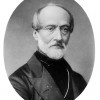 On January 1837, Giuseppe Mazzini, exiled Italian patriot, arrived in London. Image: Photograph of Giuseppe Mazzini, 1 January 1860 (author unknown). This image is in the public domain in the United States because its copyright has expired.
On January 1837, Giuseppe Mazzini, exiled Italian patriot, arrived in London. Image: Photograph of Giuseppe Mazzini, 1 January 1860 (author unknown). This image is in the public domain in the United States because its copyright has expired.
Articles
Marjorie Stone, “On the Post Office Espionage Scandal, 1844″
Kate Lawson, “Personal Privacy, Letter Mail, and the Post Office Espionage Scandal, 1844″
Related Articles
Alison Chapman, Alison Chapman, “On Il Risorgimento″
Associated Places
UmbriaPetition on Post Office spying
14 Jun 1844
 On 14 June 1844, a petition was presented to the House of Commons concerning secret Post Office spying on the contents of the letters of Joseph Mazzini and three associates. Image: Photograph of Giuseppe Mazzini, 1 January 1860 (author unknown). This image is in the public domain in the United States because its copyright has expired.
On 14 June 1844, a petition was presented to the House of Commons concerning secret Post Office spying on the contents of the letters of Joseph Mazzini and three associates. Image: Photograph of Giuseppe Mazzini, 1 January 1860 (author unknown). This image is in the public domain in the United States because its copyright has expired.
Articles
Marjorie Stone, “On the Post Office Espionage Scandal, 1844″
Kate Lawson, “Personal Privacy, Letter Mail, and the Post Office Espionage Scandal, 1844″
Associated Places
Palace of WestminsterCarlyle letter on Mazzini published
19 Jun 1844
 On 19 June 1844, Thomas Carlyle’s letter to The Times defending Mazzini was published. Image: Photograph of Giuseppe Mazzini, 1 January 1860 (author unknown). This image is in the public domain in the United States because its copyright has expired.
On 19 June 1844, Thomas Carlyle’s letter to The Times defending Mazzini was published. Image: Photograph of Giuseppe Mazzini, 1 January 1860 (author unknown). This image is in the public domain in the United States because its copyright has expired.
Articles
Marjorie Stone, “On the Post Office Espionage Scandal, 1844″
Kate Lawson, “Personal Privacy, Letter Mail, and the Post Office Espionage Scandal, 1844″
Associated Places
No places have been associated with this event On 2 July 1844, evidence was presented to the House of Commons for collusion between British and Austrian authorities in the rendition of information from Mazzini’s letters. Image: Photograph of Giuseppe Mazzini, 1 January 1860 (author unknown). This image is in the public domain in the United States because its copyright has expired.
On 2 July 1844, evidence was presented to the House of Commons for collusion between British and Austrian authorities in the rendition of information from Mazzini’s letters. Image: Photograph of Giuseppe Mazzini, 1 January 1860 (author unknown). This image is in the public domain in the United States because its copyright has expired.
Articles
“On the Post Office Espionage Scandal, 1844″
Kate Lawson, “Personal Privacy, Letter Mail, and the Post Office Espionage Scandal, 1844″
Associated Places
Palace of WestminsterBandiera brothers executed
2 Jul 1844
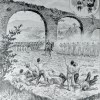 On 23 July 1844, execution in the Kingdom of the Two Sicilies of Mazzinian disciples and Italian nationalist revolutionaries Attilio and Emilio Bandiera with seven associates. Image: Print depicting the execution of the Bandiera brothers (1887), Museo Nazionale del Risorgimento, Torino. This image is in the public domain in the United States because its copyright has expired.
On 23 July 1844, execution in the Kingdom of the Two Sicilies of Mazzinian disciples and Italian nationalist revolutionaries Attilio and Emilio Bandiera with seven associates. Image: Print depicting the execution of the Bandiera brothers (1887), Museo Nazionale del Risorgimento, Torino. This image is in the public domain in the United States because its copyright has expired.
Related Articles
Marjorie Stone, “On the Post Office Espionage Scandal, 1844″
Associated Places
The Kingdom of the Two SiciliesUmbria
Naples
Tuscan uprising
1 Feb 1848
 Tuscan patriotic upraising against Austrian Duke (February 1848), which led to a short-lived constitution. Image: An image of non-unified Italy (1815-1870), William Shepherd, Historical Atlas (New York: Henry Holt and Company, 1911). This image is in the public domain in the United States because its copyright has expired.
Tuscan patriotic upraising against Austrian Duke (February 1848), which led to a short-lived constitution. Image: An image of non-unified Italy (1815-1870), William Shepherd, Historical Atlas (New York: Henry Holt and Company, 1911). This image is in the public domain in the United States because its copyright has expired.
To supporters of Italian independence, the short-lived uprising in Tuscany, leading to a new constitution as well as freedom of the press and of religious practice, seemed to be the first step to overthrowing foreign rulers
Articles
Alison Chapman, "On Il Risorgimento"
Articles
Marjorie Stone, “On the Post Office Espionage Scandal, 1844″
Associated Places
TuscanyUmbria
Pisa
Florence, Italy
Lombardy
Turin
Piedmont-Sardinia
 On 4 March 1848, the Illustrated London News publishes a special commemorative double number (numbers 305 and 306, vol. 12), “The French Revolution.” Image: Masthead of the Illustrated London News. This image is in the public domain in the United States because its copyright has expired.
On 4 March 1848, the Illustrated London News publishes a special commemorative double number (numbers 305 and 306, vol. 12), “The French Revolution.” Image: Masthead of the Illustrated London News. This image is in the public domain in the United States because its copyright has expired.
Articles
Jo Briggs, “1848 and 1851: A Reconsideration of the Historical Narrative”
Associated Places
No places have been associated with this eventRoman Republic
9 Feb 1849 to Jul 1849
 The Roman Republic existed from 9 February 1849 to 3 July 1849. The Republic was established after Pope Pius IX fled to Gaeta to the protection of King Ferdinand II of Naples, following the assassination of the papal Minister of Justice. Image: Lithograph of 'Proclamazione delle Repubblica Romana', 1849 (published in 1861). This image is in the public domain in the United States because its copyright has expired.
The Roman Republic existed from 9 February 1849 to 3 July 1849. The Republic was established after Pope Pius IX fled to Gaeta to the protection of King Ferdinand II of Naples, following the assassination of the papal Minister of Justice. Image: Lithograph of 'Proclamazione delle Repubblica Romana', 1849 (published in 1861). This image is in the public domain in the United States because its copyright has expired.
Articles
Alison Chapman, "On Il Risorgimento"
Related Articles
Marjorie Stone, “On the Post Office Espionage Scandal, 1844″
Erik Simpson, “On Corinne, Or Italy″
Associated Places
GaetaUmbria
Pisa
Florence, Italy
Calabria
Naples
Rome, Italy
Lombardy
Turin
Piedmont-Sardinia
Urbania
Associated Places
No places have been associated with this eventSt. Mark's Clock Adds Digital Format
1857 to 1859
Associated Places
No places have been associated with this eventBattle of Magenta
4 Jun 1859
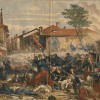 The Battle of Magenta: On 4 June 1859, the combined armies of France and Sardinians defeat the Austrians; Austria withdraws from part of Lombardy; Napoleon III and Victor Emanuel triumphantly enter Milan. Image: Adolphe Yvon, Battle of Magenta (1863), Uniformes 68 (1982). This image is in the public domain in the United States because its copyright has expired.
The Battle of Magenta: On 4 June 1859, the combined armies of France and Sardinians defeat the Austrians; Austria withdraws from part of Lombardy; Napoleon III and Victor Emanuel triumphantly enter Milan. Image: Adolphe Yvon, Battle of Magenta (1863), Uniformes 68 (1982). This image is in the public domain in the United States because its copyright has expired.
Articles
Alison Chapman, "On Il Risorgimento"
Related Articles
Marjorie Stone, “On the Post Office Espionage Scandal, 1844″
Associated Places
MagentaUmbria
Ravenna
Lombardy
Turin
Battle of Solferino
24 Jun 1859
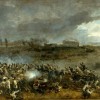 Battle of Solferino on 24 June 1859: On this date, the French defeat Austria at Solferino, forcing a full retreat of the Austrians from Lombardy in Northern Italy. Image: Luigi Norfini, Battaglia di San Martino (c. 1860s). This image is in the public domain in the United States because its copyright has expired.
Battle of Solferino on 24 June 1859: On this date, the French defeat Austria at Solferino, forcing a full retreat of the Austrians from Lombardy in Northern Italy. Image: Luigi Norfini, Battaglia di San Martino (c. 1860s). This image is in the public domain in the United States because its copyright has expired.
Articles
Alison Chapman, "On Il Risorgimento"
Related Articles
Marjorie Stone, “On the Post Office Espionage Scandal, 1844″
Associated Places
SolferinoUmbria
Ravenna
Lombardy
Turin
Poems before Congress
12 Mar 1860
 On 12 March 1860, publication of Elizabeth Barrett Browning's Poems before Congress. Image: An 1871 engraving of an 1859 photograph of Elizabeth Barrett Browning (photograph by Macaire Havre, engraving by T. O. Barlow). This image is in the public domain in the United States because its copyright has expired.
On 12 March 1860, publication of Elizabeth Barrett Browning's Poems before Congress. Image: An 1871 engraving of an 1859 photograph of Elizabeth Barrett Browning (photograph by Macaire Havre, engraving by T. O. Barlow). This image is in the public domain in the United States because its copyright has expired.
Articles
Alison Chapman, "On Il Risorgimento"
Related Articles
Marjorie Stone, “On the Post Office Espionage Scandal, 1844″
Associated Places
UmbriaIn January 1861, publication of Theodosia Trollope's Social Aspects of the Italian Revolution, a collection of Trollope’s essays on the Tuscan uprisings of 1859-1860, originally published in the Athenaeum.
Articles
Alison Chapman, "On Il Risorgimento"
Related Articles
Marjorie Stone, “On the Post Office Espionage Scandal, 1844″
Associated Places
UmbriaItaly is united
1 Feb 1861
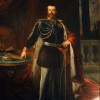 On February 1861, Vittorio Emanuele II of Piedmont is crowned king of Italy: Italy is formally united, with Turin as the capital city. Image: Vittorio Emanuele II of Savoia (c. 1840s-1850s), Museo nazionale del Risorgimento, Torino (author unknown). This image is in the public domain in the United States because its copyright has expired.
On February 1861, Vittorio Emanuele II of Piedmont is crowned king of Italy: Italy is formally united, with Turin as the capital city. Image: Vittorio Emanuele II of Savoia (c. 1840s-1850s), Museo nazionale del Risorgimento, Torino (author unknown). This image is in the public domain in the United States because its copyright has expired.
Articles
Alison Chapman, "On Il Risorgimento"
Related Articles
Marjorie Stone, “On the Post Office Espionage Scandal, 1844″
Associated Places
TurinUmbria
Pisa
Florence, Italy
Ravenna
The Kingdom of the Two Sicilies
Calabria
Naples
Gaeta
Emilia-Romagna
Rome, Italy
Lombardy
Piedmont-Sardinia
Urbania
Modena
Bologna
Parma
Life of Gustav Klimt
14 Jul 1862 to 6 Feb 1918
Associated Places
No places have been associated with this eventAssociated Places
No places have been associated with this eventby Jacob Hussey
Austro-Prussian War
14 Jun 1866 to 2 Aug 1866
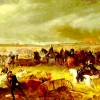 Austro-Prussian War (also known as the Third Italian Independence War or the Seven Weeks’ War), was fought from 14 June 1866 to 23 August 1866, after which Italy gains Venice from Austria. Image: The Battle of Königgrätz, by Georg Bleibtreu. This image is in the public domain in the United States because its copyright has expired.
Austro-Prussian War (also known as the Third Italian Independence War or the Seven Weeks’ War), was fought from 14 June 1866 to 23 August 1866, after which Italy gains Venice from Austria. Image: The Battle of Königgrätz, by Georg Bleibtreu. This image is in the public domain in the United States because its copyright has expired.
Articles
Alison Chapman, "On Il Risorgimento"
Related Articles
Marjorie Stone, “On the Post Office Espionage Scandal, 1844″
Associated Places
UmbriaVenice
Prague
Schönbrunn Palace
Lombardy
Frankfurt
Franco-Prussian War
19 Jul 1870 to 10 May 1871
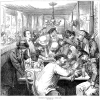 The Franco-Prussian War was fought from 19 July 1870 to 10 May 1871. The war ended with the defeat of Napoleon III and the unification of Germany; Italy gained the Papal States and Rome became the capital of Italy. Image: Frederick Barnard, "Discussing the War in a Paris Café" - a scene from the brief interim between the Battle of Sedan and Siege of Paris during the Franco-Prussian War, published in The Illustrated London News, 17 September 1870. This image is in the public domain in the United States because its copyright has expired.
The Franco-Prussian War was fought from 19 July 1870 to 10 May 1871. The war ended with the defeat of Napoleon III and the unification of Germany; Italy gained the Papal States and Rome became the capital of Italy. Image: Frederick Barnard, "Discussing the War in a Paris Café" - a scene from the brief interim between the Battle of Sedan and Siege of Paris during the Franco-Prussian War, published in The Illustrated London News, 17 September 1870. This image is in the public domain in the United States because its copyright has expired.
Articles
Alison Chapman, "On Il Risorgimento"
Related Articles
Marjorie Stone, “On the Post Office Espionage Scandal, 1844″
Associated Places
UmbriaAmiens
Ravenna
Lombardy
Urbania
Rome annexed to Italy
2 Oct 1870
Plebiscite annexes Rome and Latium to the Kingdom of Italy, 2 October 1870. This event marks the final phase of the unification of Italy.
Articles
Alison Chapman, "On Il Risorgimento"
Related Articles
Marjorie Stone, “On the Post Office Espionage Scandal, 1844″
Associated Places
Rome, ItalyUmbria
Ravenna
The Kingdom of the Two Sicilies
Calabria
Naples
Gaeta
Lombardy
Turin
Piedmont-Sardinia
Associated Places
No places have been associated with this eventAssociated Places
No places have been associated with this eventAssociated Places
No places have been associated with this eventby Laura Titzer
Associated Places
No places have been associated with this eventby Jacob Hussey
St. Mark's Campanile Collapses
14 Jul 1902
Associated Places
No places have been associated with this eventFirst Powered Human Flight
17 Dec 1903
Associated Places
No places have been associated with this eventAssociated Places
No places have been associated with this eventAssociated Places
No places have been associated with this eventPsychological Cognitive Revolution
1950 to 1980
Associated Places
No places have been associated with this eventSt. Mark's Clock Overhaul
1951 to 1953
Associated Places
No places have been associated with this eventThe First Practical Solar Cell
25 Apr 1954
Associated Places
No places have been associated with this eventRediscovery of Leonardo da Vinci's Notebook
1957 to 1957
Associated Places
No places have been associated with this eventAssociated Places
No places have been associated with this eventShakey the Robot is Developed
1966 to 1972
Associated Places
No places have been associated with this eventStanford Prison Experiment
14 Aug 1971 to 20 Aug 1971
Associated Places
No places have been associated with this eventInvention of the World Wide Web
Mar 1989
Associated Places
No places have been associated with this eventSojourner Explores Mars
4 Jul 1997 to 27 Sep 1997
Associated Places
No places have been associated with this eventPrototype of Da Vinci's Mechanical Knight
2002 to 2002
Associated Places
No places have been associated with this eventIBM's Watson
2011 to 2011
Associated Places
No places have been associated with this eventRestoration of the Moors
Autumn 2014
Associated Places
No places have been associated with this eventAssociated Places
No places have been associated with this eventtest for the future
circa. 2046
This is a future event
Associated Places
No places have been associated with this eventFounding of Venice
25 Mar 421
The mythical foundation of Venice (during the feast of the Annunciation of the Virgin) is said to have occurred on 25 March 421. 421 is also the legendary date for the foundatin of the church of San Giacomo di Rialto (next to the Rialto bridge in Venice). Image: San Giacomo di Rialto. This file is licensed under the Creative Commons Attribution Share Alike 4.0 International license.
Associated Places
No places have been associated with this eventDalmatia conquered by Venetian empire
Studies on Optics
Invention of Movable Type in China
The Beginnings of the Arsenal of Venice
The First Fractional Distillation
Third Crusade
Fourth Crusade
Venice extends empire over Greek islands
Venice opens up trade with the Mongol Empire
University of Padova Established
The University of Padua and anatomic studies in the Renaissance
Fondaco dei Turchi
Taddeo Alderotti Improves the Fractional Distillation Process
Florin
Wars with Genoa
Marco Polo and the East
Life of Giotto
The Guild of Crystal Workers
Invention of the Eyeglasses
Costs and Benefits of Making Glass
The Serrata (Closing of the Great Council)
Contributions of Spina
Construction of the Doge's Palace:
Giordanos' Sermon
Creation of the Council of Ten
English Chapel Royal:
Expanding The Arsenal of Venice
Life of Guisto de’ Menabuoi
War with the Della Scala empire
Bubonic Plague Hits Europe
1348 Black Death reduced the Venetian population by one half
Portrait of Hugh of Saint-Cher
Syria-Venice Trade Route Established
Western Schism (Papal Schism)
Fourth Genoese War (War of Chiogga)
Treviso under seige
Life of Donatello
War for control of Padua
Life of Jacopo Bellini
Medici's Move to Florence
Shift from Tempera Paints to Oil Paints
Destruction of Damascus
Popularity of Patronage
Trend of Patronage
First Experiments with Cristallo
Council of Constance resolves Western Schism
Friuli placed under Venetian control
Fall of Constantinople
Wars in Lombardy:
Joan of Arc's Victory
Gutenberg's Printing Shop
Life of Mauro Codussi
Aldus Manutius
Gutenberg Printing Press
Leonardo da Vinci
Fall of Constantinople
Gutenberg Bible Published
Construction of Porta di Terra
Lorenzo de Medici
Sixtus IV Reigns as Pope
Nicolaus Copernicus
Oldest Surviving Pair of Glasses
Sebastiano Serlio
Gian Giorgio Trissino
The Revolving Bridge
da Vinci's Catapult
The Lady with an Ermine
da Vinci'a Parachute
The Ideal City
Ornithopter
Birth of Venus Painting
Giant Crossbow
Oration on the Dignity of Man
The Armored Car
Venice Annexs Cyprus
Vitruvian Man
Tiziano (Titian) Vecelli
Rodrigo Borgia Reigns as Pope Alexander VI
Christopher Columbus Discovers the "New World"
Establishment of the Aldine Press
First Edition from the Aldine Press
Leonardo's Mechanical Knight
St. Mark's Clock Tower Construction Begins
Michaelangelo’s Pieta Finished
Girolamo Savonarola was Executed for Criticisms of the Church
Custodians Live in St. Mark's Clock Tower
St. Mark's Clock Revealed
Glasses available to the general public
Fantasia Music:
da Vinci's Scuba Gear
Harmonice Musices Odhecaton
Development of Italics
Statue of David Unveiled to the Public
Life of Thomas Tallis:
Da Vinci and the Human Heart
Painting of Sistine Chapel
Life of Andrea Palladio
Life of Bartolomeo Eustachi
The Medici Family Returns from Exile
The Life of Antonio da Ponte:
Commentariolus published by Copernicus
Life of Andreas Vesalius
Daniele Barbaro
La segregazione degli ebrei
Eyeglasses with Concave Lenses
Luther's Ninety-Five Theses
First Printed Talmud
Madrigal Vocal Music:
Life of Giovanni Antonio Rusconi
First Modern-Language Translation of Vitruvius's De Architectura Published:
The Spiritual Exercises of Ignatius of Loyola were Composed
Wars of Religion
Paracelsus Uses Diethyl Ether as an Analgesic
Paracelsus Uses the Name "Zink"
Sack of Rome
Paracelsus Adds Salt to Create a Trinity of Alchemical Elements
Paracelsus Develops the Study of Iatrochemistry
Villa Trissino in Cricoli
Who Ivan the Terrible Actually Was
Palladian Window
Venetian polychoral style
the Last Judgement by Michelangelo
Villa Pisani Bonetti
Villa Godi
De humani corporis fabrica
Copernicus's De revolutionibus orbium coelestium is published
De humani corporis fabrica
Life of William Byrd:
Council of Trent
Tre Savi sopra Eresia
Vincenzo Scamozzi
Palladian Basilica
The Venetian School
Life of Giovanni Gabrieli
Peace of Augsburg
Index Librorum Prohibitorum was First Published
Construction of the New Prison:
San Francesco della Vigna facade
Life of Antonio Contin
Villa Capra "La Rotonda"
I quattro libri dell'architettura published
The Introduction of the Galleass into the Venetian Fleet:
Saint Bartholomew's Massacre
Il Redentore
The 1577 Fire in the Doge's Palace:
Galileo published Du Motu (On Motion)
Songs of Sundrie Natures:
My Ladye Nevells Booke:
The University of Padova’s Anatomical Theater
Padova Anatomical Theater
Dafne, the First Opera
Shakespeare's Globe Theatre
Portrait of Cardinal Fernando Niño de Guevara
Baroque Period (Music):
Counterpoint:
Construction of the Bridge of Sighs:
Shakespeare's Hamlet
Relation aller Furnemmen und gedenckwurdigen Historien
Invention of the Telescope
Galileo's Early Telescope
The Starry Messenger is published by Galileo
Keplerian Telescope Invented
Naming of the Telescope
Galileo published Discourse on Bodies of Water
Galileo published Dialogue Concerning the Two Chief World Systems
Galileo is tried by the Inquisition
Invention of the Micrometer
Theodore de Mayerne Confirms Hydrogen Gas is Flammable
Decline of the Venetian Navy
Publication of Systema Saturnium
Invention of the Reflecting Telescope
Digesting Duck
St. Mark's Clock Renovation
Giacomo Casanova's Escape from the Doge's Palace:
St. Mark's Clock Tower Magi Schedule Changed
French Revolution
Execution of King Louis XVI
Reign of Terror
Volta Invents the First Chemical Battery
Napolean and the Arsenal of Venice
Napoleon made king of Italy
Mary Shelley's Frankenstein
Mazzini's arrival in London
Petition on Post Office spying
Carlyle letter on Mazzini published
House of Commons investigates Post Office spying
Bandiera brothers executed
Tuscan uprising
Illustrated London News's "The French Revolution"
Roman Republic
First Human Glider Flight
St. Mark's Clock Adds Digital Format
Battle of Magenta
Battle of Solferino
Poems before Congress
Social Aspects of the Italian Revolution
Italy is united
Life of Gustav Klimt
Kingdom of Italy revitalizes the Arsenal of Venice
Austro-Prussian War
Franco-Prussian War
Rome annexed to Italy
First Psychology Lab
The First Practical Electric Car
Invention of the Linotype Machine
The Battleship Francesco Morosini
St. Mark's Campanile Collapses
First Powered Human Flight
Metropolis Film is Released
Maslow's Hierarchy of Needs
Psychological Cognitive Revolution
St. Mark's Clock Overhaul
The First Practical Solar Cell
Rediscovery of Leonardo da Vinci's Notebook
Unimate is Installed
Shakey the Robot is Developed
Stanford Prison Experiment
Invention of the World Wide Web
Sojourner Explores Mars
Prototype of Da Vinci's Mechanical Knight
IBM's Watson
Restoration of the Moors
Europe calls for mandatory 'kill switches' on robots
test for the future
Founding of Venice
Chronological table
|
Date |
Event | Created by | Associated Places | |
|---|---|---|---|---|
| 4 Mar 1848 |
Illustrated London News's "The French Revolution"
ArticlesJo Briggs, “1848 and 1851: A Reconsideration of the Historical Narrative” |
David Rettenmaier | ||
| 9 Feb 1849 to Jul 1849 |
Roman Republic
ArticlesAlison Chapman, "On Il Risorgimento" Related ArticlesMarjorie Stone, “On the Post Office Espionage Scandal, 1844″ |
David Rettenmaier | ||
| 1853 |
First Human Glider FlightSir George Cayley, an English engineer, was the first to successfully study and understand the underlying principles associated with powered flight, as well as the first to accomplish unpowered flight without use of a balloon. He was the first to theorize about fixed wing aircraft, and determined that the system would need a separate propulsion system and a stabilizing tail. He also determined that the wings of an aircraft would need to be curved (have camber) to efficiently generate lift. He would go on to be the first human to fly on a glider in 1853, proving his theories on lift and aviation. His work greatly influenced the Wright Brothers and their invention of the powered aircraft. The included image is his glider, published in Mechanics Magazine in 1852, and found on Wikimedia. |
Catriona White | ||
| 1857 to 1859 |
St. Mark's Clock Adds Digital FormatThe building and mechanism required repair in the 1850s. The custodian and a clock technician wrote a technical brief about the state of the Clock Tower and the repairs they deemed necessary to complete. Luigi De Lucia was tasked with making these repairs. Also, a committee asked him to figure out a way to show the time in the dark. De Lucia decided to use illuminated panelled wheels that display the time in five minute intervals. This addition was one of the first tower clocks that used a digital format. Image By Tony Hisgett from Birmingham, UK (Clock Tower St Mark's Square 3 Uploaded by tm) [CC BY 2.0 (http://creativecommons.org/licenses/by/2.0)], via Wikimedia Commons |
Mikaela Meyer | ||
| 4 Jun 1859 |
Battle of Magenta
ArticlesAlison Chapman, "On Il Risorgimento" Related ArticlesMarjorie Stone, “On the Post Office Espionage Scandal, 1844″ |
David Rettenmaier | ||
| 24 Jun 1859 |
Battle of Solferino
ArticlesAlison Chapman, "On Il Risorgimento" Related ArticlesMarjorie Stone, “On the Post Office Espionage Scandal, 1844″ |
David Rettenmaier | ||
| 12 Mar 1860 |
Poems before Congress
ArticlesAlison Chapman, "On Il Risorgimento" Related ArticlesMarjorie Stone, “On the Post Office Espionage Scandal, 1844″ |
David Rettenmaier | ||
| Jan 1861 |
Social Aspects of the Italian RevolutionIn January 1861, publication of Theodosia Trollope's Social Aspects of the Italian Revolution, a collection of Trollope’s essays on the Tuscan uprisings of 1859-1860, originally published in the Athenaeum. ArticlesAlison Chapman, "On Il Risorgimento" Related ArticlesMarjorie Stone, “On the Post Office Espionage Scandal, 1844″ |
David Rettenmaier | ||
| 1 Feb 1861 |
Italy is united
ArticlesAlison Chapman, "On Il Risorgimento" Related ArticlesMarjorie Stone, “On the Post Office Espionage Scandal, 1844″ |
David Rettenmaier | ||
| 14 Jul 1862 to 6 Feb 1918 |
Life of Gustav KlimtArtist Gustav Klimt was born in Baumgarten, Austrian Empire on July 14, 1862. Klimt was influential in the Vienna Secession movement and devoted his life to his work, with a particular interest in painting the female body. Klimt's most famous work is his piece The Kiss (Lovers) which he finished in 1908 during his "Golden Period". This period was named as such because many of his works included gold leaf and were primarily painted in the color gold. Klimt was a controverisal artist who pushed the boundaries and even made the public feel uncomfortable at times with his erotic pieces. His depictions of the naked female body are very reminiscent of Renaissance period artwork. Image source: http://www.leopoldmuseum.org/en/leopoldcollection/focus/Klimt |
Caroline Brown | ||
| 1866 |
Kingdom of Italy revitalizes the Arsenal of VeniceIn 1866, after Venice became a part of the Kingdom of Italy, the Italians decided to modernize the Arsenal of Venice to help it be able to make steam-powered naval units such as the the "Ironclad" made famous in the American Civil War. Although the Italians had to make changes to the structure for the new classes of naval vessels, it desired to make sure the historic parts of it remain the same. This tradition off kepping Venice the same way it was back centuries prior still continues to this day. Source: http://www.venicethefuture.com/schede/uk/316?aliusid=316 This work is in the public domain in its country of origin and other countries and areas where the copyright term is the author's life plus 100 years or less. |
Jacob Hussey | ||
| 14 Jun 1866 to 2 Aug 1866 |
Austro-Prussian War
ArticlesAlison Chapman, "On Il Risorgimento" Related ArticlesMarjorie Stone, “On the Post Office Espionage Scandal, 1844″ |
David Rettenmaier | ||
| 19 Jul 1870 to 10 May 1871 |
Franco-Prussian War
ArticlesAlison Chapman, "On Il Risorgimento" Related ArticlesMarjorie Stone, “On the Post Office Espionage Scandal, 1844″ |
David Rettenmaier | ||
| 2 Oct 1870 |
Rome annexed to ItalyPlebiscite annexes Rome and Latium to the Kingdom of Italy, 2 October 1870. This event marks the final phase of the unification of Italy. ArticlesAlison Chapman, "On Il Risorgimento" Related ArticlesMarjorie Stone, “On the Post Office Espionage Scandal, 1844″ |
David Rettenmaier | ||
| 1879 |
First Psychology LabThe world's first psychology lab was founded by Wilhelm Wundt at the University of Leipzig in Germany. This event is viewed as what catapulted psychology into the world of academia, taking it from a theoretical discipline to a scientific one. The creation of the lab truly turned psychology into its own discipline, rather than just a mixture of biology and philosophy. Wundt did research primarily on structuralism, which breaks down cognitions into their components and studying those basics elements. Image source: http://psychclassics.yorku.ca/Munster/Lab/ |
Caroline Brown | ||
| 1884 |
The First Practical Electric CarThomas Parker, an inventor from London and leading researcher in batteries and electricity at the time, built the first production car to be electric-powered. These galvanic cell-powered vehicles were built using Parker's own high-capacity rechargeable batteries. Parker dedicated his life to the development and manufacturing of more fuel-efficient cars and the optimization of galvanic battery cell chemistry. This interest was a result of his concern about the detrimental effects of smoke and pollution in urban London. Image source: Public Domain, https://upload.wikimedia.org/wikipedia/commons/e/e7/Thomas_Parker_Electr... |
Ryan Gansemer | ||
| 1884 |
Invention of the Linotype MachineThe linotype machine was invented in 1884 by Ottmar Mergenthaler in the United States of America. A linotype machine works with a matrix molded system. An operator can type the desired text in a keyboard on the machine and the machine will fill in the letters required for each line of text, including spaces. The linotype machine revolutionized the process of printing, especially items, such as newspaper, that required many small lines of text. This image was sourced from Wikimedia Commons. |
Laura Titzer | ||
| 1885 |
The Battleship Francesco MorosiniIn the year 1885 at the Arsenal of Venice, the first Venetian battleship, Franceso Morosini, was built. Venice was able to produce such a large ship thanks to scientific advancements such the Bessemer Process which made mass production of steel a lot quicker than ever before. However, even though the construction of this ship was a great feat, the late 1800s were the last of Arsenal of Venice's days of large production of naval ships. The Francesco Morosini marks the end of an era for Venice as its days of superior naval production are long past. Source: From craft production to industrial production. (n.d.). Retrieved February 07, 2017, from http://arsenalofvenice.weebly.com/from-craft-production-to-industrial-production.html This photograph is in the public domain in Italy because it was first published in Italy and its term of copyright has expired. According to Law for the Protection of Copyright and Neighbouring Rights n.633, 22 April 1941 |
Jacob Hussey | ||
| 14 Jul 1902 |
St. Mark's Campanile CollapsesThe Campanile (bell tower) collapsed suddenly due to multiple construction flaws. No one died in the collapse except for the Campanile's custodian's cat. Fortunately, the church was saved because the corner column did not collapse. The Municipal Administration promised that the Campanile would be rebuilt just as it was. This is an image of the ruins after the collapse. See page for author [Public domain], via Wikimedia Commons, https://commons.wikimedia.org/wiki/File%3ARuins_of_St_Mark's_Campanile.jpg |
Mikaela Meyer | ||
| 17 Dec 1903 |
First Powered Human FlightWilbur and Orvill Wright were the first to perform a powered fight on what would become the precursor to all modern aircraft. The pair of brothers observed birds and avidly read the work of Sir George Cayley to create their aircraft. Leading up to the first successful aircraft, they preformed preliminary wind tunnel testing in their bicycle shop to predict aircraft performance, combined a rudder with warped wings to perform coordinated turns, developed their own gas powered engine, and created a highly efficient professor. Their first famous flight in Kitty Hawk North Carolina lasted for 12 seconds and flew 120 feet. The Wright brothers flew multiple times that day, the longest lasting 59 seconds and travelling 852 feet. This marked the beginning of the development of the aircraft that is used today. The image is from the first day of flight and is from Wikimedia commons. |
Catriona White | ||
| 1927 |
Metropolis Film is ReleasedIn 1927, Metropolis was the first movie to portray a humanoid robot in film. This piece is one of the first works of the science-fiction genre. In Metropolis, the son of the city ruler and a poor worker team up to try and overcome the large separation between the classes in this futuristic urban dystopia. Image is a picture of the humanoid robot from the movie Metropolis retrieved from Unknown - archivio personale, Public Domain, https://commons.wikimedia.org/w/index.php?curid=43577653. |
Susannah Pritchett-Montavon | ||
| 1943 |
Maslow's Hierarchy of NeedsAbraham Maslow is a humanist psychologist who focused his research on the positive qualities that people possess, rather than seeing them as a bag of issues that needs to be fixed. The humanist movement in psychology helped shape the current world of psychology and focuses on how people are innately good and capable of changing their own worlds. The hierarchy of needs is based around the idea of self actualization, which is the top of the pyramind. Only 1 in 100 people achieve self-actualization by the end of their lifetime. Each level must be fulfilled before proceeding on to the next. The bottom of the pyramid is physiological needs like water, shelter, and rest. The next level is safety needs, then belongingness, esteem, and finally self-actualization. The pyramid progresses in a way that each section of a person's life fits in to one of the categories. When you're born you mostly just need rest and to be fed. Then as you get older your needs become more complex. Image source: http://www.huffingtonpost.com/steve-mariotti/how-to-get-from-here-to-t_b... |
Caroline Brown | ||
| 1950 to 1980 |
Psychological Cognitive RevolutionThe Cognitive Revolution in psychology was prompted by the Behaviorism movement. The Behaviorists focused their research primarily on observable behavior alone, completely disregarding any mental events because they couldn't be directly observed. Famous behaviorists include Ivan Pavlov and John Watson. Cognitive psychologists believe that the mind is complex and there are many different explanations for behavior. They tend to use a computer metaphor, with the hardware being what humans biologically have and the software being cognitions and patterns of thought. The cognitive revolution changed the world of psychology completely and helped shape it into the one we know today. Image source: http://www.creativitycenter.ch/bloc_deroulant/jean-piaget-and-genetic-ep... |
Caroline Brown | ||
| 1951 to 1953 |
St. Mark's Clock OverhaulGiovanni Peratoner was the custodian in 1951 when the overhaul began. The overhaul was necessary because the Tower building had moved slightly over time, so the bob did not reach the room below it. In order to overhaul the movement, Peratoner raised the pendulum's point of suspension. The clock was up and running again in 1953. Image by By Juan Manuel Caicedo [CC BY-SA 2.0 (http://creativecommons.org/licenses/by-sa/2.0)], via Wikimedia Commons |
Mikaela Meyer | ||
| 25 Apr 1954 |
The First Practical Solar CellBell Laboratory scientists Calvin Fuller and Gerald Pearson announced the invention of the first practical silicon-based solar cell. These cells were later displayed at the National Academy of Science Meeting. This cell was also used to power a solar-powered radio transmitter, which broadcasted this meeting. Initially, the solar cells had an efficiency of 6%, but today commercial solar panels have up to 20% efficiency. The New York Times speculated that these cells "may provide more power than all the world's coal, oil, and uranium," which excited engineers around the globe. Image: Public Domain, https://commons.wikimedia.org/wiki/Solar_cell#/media/File:Solar_cell.png |
Ryan Gansemer | ||
| 1957 to 1957 |
Rediscovery of Leonardo da Vinci's NotebookIn 1957, Italian historian, Carlo Pedretti, rediscovered Leonardo da Vinci’s notebook. The notebook included the notes and sketches for da Vinci’s anatomical research and many mechanical designs, including the mechanical knight. The image is one of the pages from da Vinci’s notebook. The notes pictured are from his anatomical study of the human arm. Image: Public Domain, https://commons.wikimedia.org/w/index.php?curid=59576 |
Susannah Pritchett-Montavon | ||
| 1961 |
Unimate is InstalledIn 1961, General Motors installed the first industrial robot in its Inland Fisher Guide Plant in New Jersey. This robot was called Unimate and it was also the first modern programmable robot; it was autonomous and pre-programmed to repeatedly move pieces of hot metal in the plant. Image is an industrial robot used in metal manufacturing. Image by KUKA Roboter GmbH, Bachmann - KUKA Roboter GmbH, Zugspitzstraße 140, D-86165 Augsburg, Germany, Dep. Marketing, Mr. Andreas Bauer, http://www.kuka-robotics.com, Public Domain, https://commons.wikimedia.org/w/index.php?curid=3346503 |
Susannah Pritchett-Montavon | ||
| 1966 to 1972 |
Shakey the Robot is DevelopedFrom 1966-1972, the Artifical Intelligence Center of Stanford institute developed the first robot with the ability to make its own decisions about how to behave. Shakey was able to receive, interpret, and execute natural language commands, even when they were multistep processes. Shakey was later inducted into the Carnegie Mellon Univerisyt’s Robot Hall of Fame in 2004. Image is a picture of Shakey the robot with its parts labelled. Image by SRI International - SRI International, CC BY-SA 3.0, https://commons.wikimedia.org/w/index.php?curid=17294520 |
Susannah Pritchett-Montavon | ||
| 14 Aug 1971 to 20 Aug 1971 |
Stanford Prison ExperimentPsychologist Philip Zimbardo masterminded this iconic experiment at Stanford University in the summer of 1971. He made a simulation of a jail and randomly assigned students to either the role of prisoner or guard. Zimbardo and associates wanted to answer the question of what causes the abuse between prisoners and guards in a prison. The experiment escalated quickly. Guards began abusing their power and unjustly punishing and harassing the prisoners. Zimbardo's simulation had morphed into something much more telling. This experiment is used as an example of the effects of power and hierarchy on behavior and is studied in most entry level psychology courses. Image source: http://www.cbsnews.com/pictures/shocking-prison-study-40-years-later-wha... |
Caroline Brown | ||
| Mar 1989 |
Invention of the World Wide WebIn March of 1989, Sir Tim Berners-Lee began the layout of what would later be the World Wide Web. He graduated from Oxford and became a software engineer at CERN shortly after. While working for CERN, Berners-Lee created the proposal for the World Wide Web. He created HTTP, HTML, the first web browser, and the first HTTP server. This allows people to read and write on the internet via the use of computers. After its creation, the World Wide Web was primarily used for scientific researchers or science departments at universities. With time though there became more web servers all around the world. The World Wide Web has had such a drastic role in the current world of online technology and data collection. Sir Tim Berners-Lee was hugely influential and will remain an icon in the online world for many years to come. Image source: http://webfoundation.org/about/vision/history-of-the-web/ |
Caroline Brown | ||
| 4 Jul 1997 to 27 Sep 1997 |
Sojourner Explores MarsOn July 4, 1997, Sojourner became the first successful Mars Pathfinder. The rover was autonomous and had front and rear cameras. The robot’s communication lasted until September 27, 1977. The rover was able to transmit approximately 550 images and more than 15 chemical analyses of rocks and soil throughout its lifespan. Image is a picture of the Sojourner. Public Domain, https://commons.wikimedia.org/w/index.php?curid=328753 |
Susannah Pritchett-Montavon | ||
| 2002 to 2002 |
Prototype of Da Vinci's Mechanical KnightIn 2002, Mark Rosheim built a prototype of da Vinci’s mechanical knight using the original schematics/notes. The construction of the knight proved that da Vinci’s original design was feasible and worked as intended. Mark Rosheim was inspired by da Vinci in his career with NASA where he designed robots. Image is a modern reconstruction of the mechanical knight in 2007 in the Leonardo3 laboratories. Image by Leonardo3 - Mario Taddei - Photo in the Leonardo3 Laboratories, GFDL, https://commons.wikimedia.org/w/index.php?curid=5666658 |
Susannah Pritchett-Montavon | ||
| 2011 to 2011 |
IBM's WatsonIn 2011 IBM’s Watson competed on the hit TV show Jeopardy. Watson is a computer system designed to answer questions posed in natural language. Watson continuously outperformed its human components, including two of the most successful Jeopardy contestants, Ken Jennings and Ben Rutter. Image is of IBM employees demonstrating Watson’s ability to play Jeopardy. Image By Raysonho @ Open Grid Scheduler / Grid Engine - Own work, CC BY 3.0, https://commons.wikimedia.org/w/index.php?curid=14967544 |
Susannah Pritchett-Montavon | ||
| Autumn 2014 |
Restoration of the MoorsThe two statues that are located on top of the Clock Tower are known as the "Moors." Venetians came up with this name because the statues' bronze color have changed over time due to interacting with the elements. Due to deterioration, the Moors have not been able to strike the bell consistently. One Moor is supposed to strike the bell two minutes before the hour, while the other is supposed to strike it two minutes after the hour. Piaget agreed to finance the restoration of the Moors in 2014. Image By Yair Haklai (Own work) [CC BY-SA 4.0 (http://creativecommons.org/licenses/by-sa/4.0)], via Wikimedia Commons |
Mikaela Meyer | ||
| 12 Jan 2017 |
Europe calls for mandatory 'kill switches' on robotsOn January 12, 2017 CNN published an article discussing the proposal by European lawmakers for all robots to be equipped with emergency “kill switches.” The article discusses the main aspects of the proposal including all robots being required to be easily identified as mechanical beings, having kill switches, and following orders from the creator at all times. Image is a photo of the European Parliament’s hemicycle. Image by Diliff - Own work, CC BY-SA 3.0, https://commons.wikimedia.org/w/index.php?curid=35972521 |
Susannah Pritchett-Montavon | ||
| circa. 2046 |
test for the futureThis is a future event |
Dino Franco Felluga |









